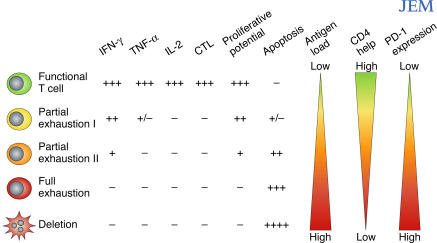Figure 1.
T cell exhaustion during chronic viral infections. Virus-specific CD8 T cells posses multiple functions including production of IFN-γ, TNF-α, IL-2, cytotoxicity, antigen-driven proliferation, and resistance to apoptosis. During chronic infections, functions can be exhausted. Exhaustion represents a spectrum from mild (Partial exhaustion I: little IL-2 and poor TNF-α and cytotoxicity) to moderate (Partial exhaustion II: modestly defective IFN-γ, cytotoxicity, and little IL-2 or TNF-α) to severe (Full exhaustion: lack of IFN-γ, TNF-α, IL-2, and cytotoxicity). Finally, physical deletion (apoptosis) of T cells occurs. Proliferative potential decreases concomitantly with the loss of other functions while apoptosis increases. Antigen and CD4 help strongly influence exhaustion; as antigen increases and/or CD4 help decreases, virus-specific T cells become more exhausted. Recent studies now identify the PD-1–PD-L pathway as a key regulator of exhaustion. Increased expression of PD-1 by virus-specific T cells, and PD-L1 by APCs, leads to more severe exhaustion during chronic viral infection.

